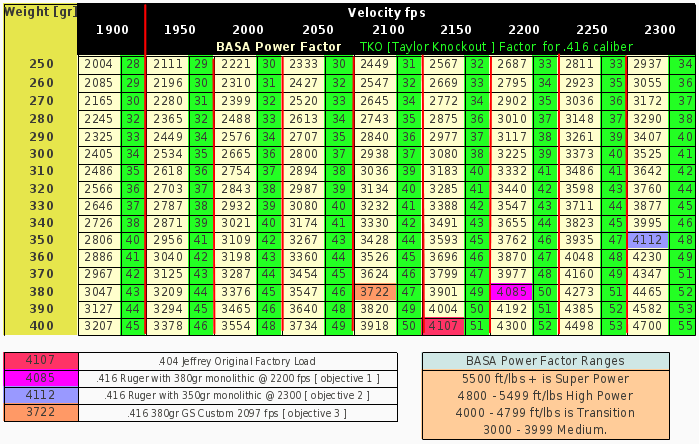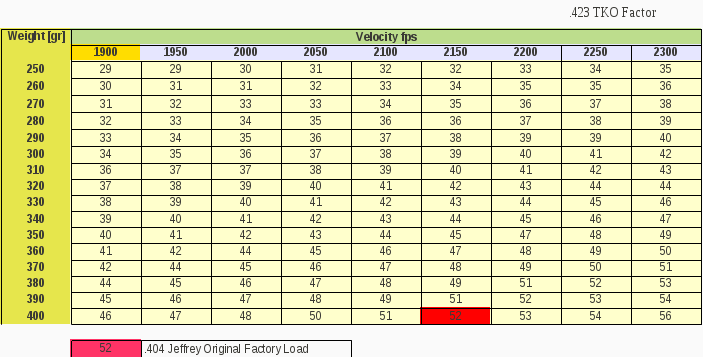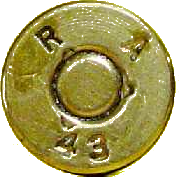Ysterhout Dot Net
The objective was to duplicate certain attributes of the original .404 Jeffrey ballistics. Strictly speaking it was not a direct caliber comparison. The Ruger is a true .416, while the Jeffrey is a .423 caliber.
By that fact alone the purists may draw the conclusion that a ballistic equivalency is not possible, hence the use of the power factor as used by the Big Bore Association of South Africa. The test was to load the 416 Ruger to the same power factor as the original .404 Jeffrey with 400gr bullets, using Somchem powder and South African monolithic bullets.
Below is a BASA power factor chart. This is drawn up using the formula
- Power Factor = ((bullet weight / 7000 ) * velocity * velocity )/64.32
It looks similar to the Taylor KO Factor formula
- ( grains * velocity * bullet diameter ) / 7000
The Taylor formula favors bullet diameter, the larger the bore for a given weight and velocity, the higher the KO value.
The green column per velocity is the Taylor KO Factor, for comparison. The TKO factor uses caliber as a variable, whereas the BASA power factor does not. The TKO values on this chart are for a .416 caliber bullet. Note the TKO of 51 for a 400gr bullet at 2150fps. Keep in mind the TKO value is caliber specific, the BASA power factor is not.

To get the same BASA power factor using
- 380gr GSCustom FN requires a velocity of close to 2250fps[ this is the primary test objective ]
- 350gr Frontier Spartan HP requires a velocity of 2300fps [ this is the secondary test objective ]
From the chart above, the 404 Jeffrey in original factory form had a BASA power factor of 4107. The TKO value for a .423 is as per the chart below.

To equal the TKO value of a 400gr .423 bullet at 2150fps, a 400gr .416 caliber bullet must move at 2200 fps. This information is provided for interest sake, the test was based on the BASA power factor only.
Velocity and power factor don't have any direct relation to performance in the field. Bullet type and construction are very important factors to consider with bullet weight and velocity, for any practical application.
Points to note are
- One of the original 404 Jeffrey factory loads was a 300gr soft bullet at 2600fps, and it was reported as being inadequate for big game hunting in Africa, but well suited to the longer ranges on soft-skinned animals in India.
- The famous elephant hunter W.D.M (Karamojo) Bell took most of his elephant with a 175gr solid from a 7x57 Mauser. As a caution on the last point, Townsend Whelen (1877-1961) commented " ... and the consensus of opinion among present-day [early 1950s] African professional white hunters is that it would be extremely dangerous for present-day sportsmen to follow his [ W.M.D Bell's ] advice on the caliber of weapons for use on the larger African game ..." .
Between those two points lie a lot of lessons that can be learned.
For more info on BASA, refer to the Big Bore site .



